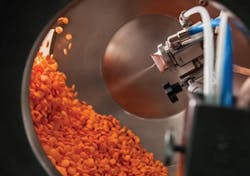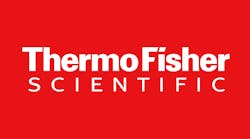Co-processed excipients are expected to play a key role in the production of new chemical entities (NCEs), according to BCC Research. As developing new excipients can be time-consuming and expensive from a safety perspective, manufacturers see co-processing of already approved excipients as an attractive alternative. These excipients are engineered to achieve the properties of the key components of the tableting blend in a single, highly flowable and compressible granular material.1 As a result, where there were less than a handful of co-processed excipients on the market 15 or 20 years ago, there now are more than 20 that are commercially available to formulators, and it is very likely that this number will continue to grow.
Kerry has been active in the development of co-processed excipients. For example, Sloane explains that the company has synergistically combined lactose with Microcrystalline Cellulose in a unique spray drying process to create Disintequik MCC25. “This co-processing of these two widely accepted excipients has created a product that compresses better, and disintegrates quicker, than could be achieved by simply blending these two excipients together.”
He adds that Kerry has also introduced a line of LubriTose self-lubricating excipients, a co-processing of Glyceryl Monostearate together with Lactose, Microcrystalline Cellulose or Mannitol. This provides formulators with a new excipient that does not require any external lubricant (magnesium stearate) to manufacture an OSD with good compaction and ejection properties. “It is it well known that incorporating an external lubricant such as magnesium stearate can lead to compression problems if the final blending step is not precisely timed, resulting in over blending,” he says. “This potential problem is avoided completely with LubriTose, as studies have shown that even prolonged blending does not have a detrimental impact on compression properties.”
Despite the advantages to producers, most co-processed excipients are not found in official monographs, which is holding back their use in the market. Additionally, Sloane says it is important that the co-processed excipient can demonstrate effectiveness in manufacturing process efficiencies, as invariably the cost of a co-processed excipient will be higher on a per/kg basis than a simple blend of the same excipients.
COATINGS BECOME MORE SOPHISTICATED
The film coatings market has also seen a dramatic shift in the last 10 years. While companies used to have to rely mainly on one film coating manufacturer, today there are several manufacturers of pharmaceutical film coatings from which a formulator can choose.
According to the 2017 Nice Insight Pharmaceutical Excipients Survey, 38 percent of respondents procure excipients to use as coatings.2 And FDA guidelines, published in March 2013, made the interchangeability of film coatings clearer and simpler for drug manufacturers, giving them more leverage when it comes to negotiating the price of film coatings. Film coatings can bring many important attributes to the tablet. For example, a film coating may protect the tablet from chipping or dusting, adding gloss, shine or whiteness to a tablet, and provide a unique color to the drug, which enables easier patient recognition and dose discrimination.
“Tablet coatings are becoming more sophisticated in terms of enabling better patient compliance or otherwise improving the consumer experience,” says Sloane. “This is especially true in the competitive OTC market where consumer appeal and preference are key differentiators.” For example, he says that Kerry has developed film coatings with attributes that appeal directly to the consumer, such as ease of swallow. Another coating developed by Kerry is Sheffcoat Enhance, which incorporates pleasant tasting flavors and aromas to the film coating.
In addition to enhancing the consumer experience, coatings can enhance the manufacturing process. “Colorcon developed Opadry QX, a quick and flexible film coating system that enables manufacturers to coat tablets in a continuous coating process with improved coating uniformity and a perfect finish in a much reduced time compared to other coatings,” says Pankaj Rege, Ph.D, MBA, general manager - manufactured excipients, Colorcon. “Opadry QX also overcomes process challenges and can be used across a range of coating equipment without compromising on the tablet finish,” he says. “The added flexibility of operating at low bed temperature settings also makes Opadry QX a film coating suited for temperature-sensitive APIs. The increased solids level, up to 35 percent, means that films are applied faster, color uniformity is reached earlier, and all coated tablets have a defect-free finished appearance.”
EXCIPIENTS ADDRESS POOR FLOW AND STABILITY
The last five years have seen a surge in the focus that pharma companies place on their excipients. This is being driven by factors such as increased demands from regulatory authorities, global supply chain scrutiny, high-potency APIs (which in turn increase the demand for highly functional excipients), Quality by Design (QbD), consolidation within the generics industry, manufacturing rationalization and budget cuts within the traditional pharmaceutical R&D companies. “The drug and excipients industries have a symbiotic relationship,” says Sloane. “Each is reliant on the other to successfully bring their products to market.”
There are many types and grades of lactose, coatings and flavors that will ultimately play a vital role in the manufacturing, appearance or sensory appeal of a product, says Sloane. Sometimes the choices can be overwhelming. Recently, one of Kerry’s Latin American customers wanted to develop a pleasant tasting orally disintegrating tablet (ODT) using direct compression. The customer worked with Kerry’s technical team to develop the right combination of excipients and flavors to accomplish their goal.
“The need to taste mask bitter APIs, especially for paediatric applications, will continue to be a focus,” says Rege. “Our Surelease, based on ethylcellulose, has been used as a successful taste mask for solid oral dosages and has precedence of use for paediatric products. Expect to see more excipient manufacturers like Colorcon innovate in this area, focusing on patient compliance aspects and developing pipeline products that improve dosage form swallowability, a conventional deterrent leading to discontinuation of therapy.”
Excipients also address issues related to poor flow, compressibility and stability. “Excipients that solve these problems help reduce development time and improve the final product,” says Rege. “As an example, the moisture scavenging activity of Starch 1500 helps protect the API in the core.”
Recently, Colorcon worked with a large generic manufacturer that was facing quality issues (variability in drug release) and resultant supply shortage. The customer substituted Starch 1500 in the core instead of the original native starch, which reduced the manufacturing complexity while improving overall tableting quality. “The customer was able to double its throughput while eliminating the variability seen in the original product,” he says. “With this simple process modification (while maintaining same excipient chemistry) the customer was able to get an FDA approval using prior approval supplement.”
DIRECT COMPRESSION AND GRANULATION STILL HAVE ISSUES
A conversation about OSD would not be complete without mentioning direct compression and granulation. The 2017 Nice Insight Pharmaceutical Equipment Survey indicates that 29 percent of respondents use tablet presses for oral solid dose processing, and 24 percent of respondents report using granulators for OSD processing.2 However, while these technologies are well understood and have been utilized for decades, formulators still tackle issues related to poor flow, compressibility and stability.
“Direct compression techniques for manufacturing tablets is by far the most efficient method for producing tablets,” says Sloane. It takes less energy, less time and less labor to produce tablets. However, this method relies on the properties and loading (i.e., the amount in the tablet) of the API itself. Ensuring content uniformity of each tablet can be more difficult to achieve when using direct compression techniques,” says Sloane. “And, while granulation can be more energy and labor intensive, as well as time consuming, some of this is offset by the use of lower cost, less functional excipients.”
WHAT'S NEXT
In the next three to five years, Sloane expects to see the advent of more co-processed excipients that fill a niche in the manufacturing of oral solid dose forms, particularly in ODT or chewables that appeal to consumers’ desire for convenience.
Excipient companies will need to ensure that their products are globally available to meet the demand for functional excipients, and that they are manufactured to the highest quality and purity standards, as well as adhering to increasing regulatory scrutiny, he says.
Additionally, traditional manufacturing techniques for tablets will likely remain unchanged, but the proportion of those made using direct compression, compared to wet or dry granulation manufacturing techniques, may be in flux, as these are dependent on the properties and potencies of the API themselves, Sloane says. “Regardless, tablets as a delivery mechanism for APIs will always be the most cost effective and simplest way to deliver medicine to patients.”
REFERENCES
Excipients in Pharmaceuticals, BCC Research, March 2016.
2017 Excipient Buying Trends, Nice Insight.





